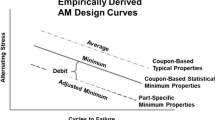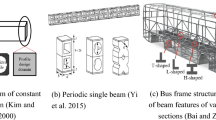Abstract
A model to predict the bending modulus of elasticity (MOE) of oriented strand board (OSB) panels produced by batch processing is presented. The approach developed herein is unique in its comprehensiveness since the MOE is determined from information on the panel structure, temperature and moisture profiles and vertical density profiles obtained from the mat formation and compression models presented in Part 1. Comparison of predicted MOE values with those measured from 24 commercially produced panels shows good agreement considering some of the uncertainties involved. Simulations show that the MOE can be increased by any of the following changes: reduced fines content, increased panel density, better flake alignment in each of the three layers within a panel, increased flake length and a larger difference between the density of the face and core layers. The model was also used in a genetic algorithm to carry out an optimization study of batch OSB manufacturing. This analysis showed that by combining the appropriate reduction in the amount of flakes used, increase in fines content, improvement in flake alignment within each of the face and core layers and shortening of the batch time, a significant theoretical profit increase from the base case scenario can be obtained.






Similar content being viewed by others
Abbreviations
- a b :
-
total board area in the (x,y) plane (m2)
- E :
-
Young’s modulus of OSB (Pa)
- HDD (x,y) :
-
local density over board thickness at each (x,y) position (kg m-3)
- k i :
-
coefficients reflecting different costs
- mc :
-
mass fraction of moisture in OSB
- M fines :
-
mass fraction of fines in OSB
- M face :
-
mass fraction of face layer
- MOE:
-
modulus of elasticity (psi)
- n :
-
number of nodes
- t :
-
time (s)
- T(x,y,z) :
-
temperature at (x,y,z) position within board (°C)
- VDP :
-
density profile along the board thickness (kg m-3)
- V :
-
volume of layer after compression
- x :
-
coordinate along the direction of board length (m)
- y :
-
coordinate along the direction of board width (m)
- z:
-
coordinate along the direction of board thickness (m)
- ε i :
-
strain within board interval i along the z-direction over which board is discretized to model compression
- ε y :
-
yield strain of OSB
- θ(t) :
-
board thickness at time t (m)
- θ E :
-
board thickness at end of pressing cycle (m)
- ρ(t) :
-
density of OSB at time t (kg m-3)
- ρ f :
-
density of wood flake (kg m-3)
- χ :
-
extent of curing (%)
- μ :
-
flake length
- E :
-
end of cycle
- para:
-
in the parallel direction
- perp:
-
in the perpendicular direction
References
Barnes D (2000) An integrated model for the effect of processing parameters on the strength properties of oriented strand wood products. Forest Prod J 50(11/12):33–42
Barnes D (2002a) A model of the effect of fines content on the strength properties of oriented strand wood composites. Forest Prod J 52(5):55–60
Barnes D (2002b) Orientation of OSB and particleboard strands for high-strength oriented strand lumber and panel products. Forest Prod J 52(9):31–39
Bodig J, Jayne BA (1982) Mechanics of wood and wood composites. Van Nostrand Reinhold Company, Toronto
Fenton TE (2002) Modelling and simulation of oriented strandboard pressing. MASc Thesis, University of Waterloo
Fenton TE, Budman HM, Pritzker MD, Bernard E, Broderick G (2003) Modeling and simulation of oriented strandboard pressing. Ind Eng Chem Res 42(21):5229–5238
Gen M (2000) Genetic algorithms and engineering optimization. Wiley, New York
Gibson RF (1994) Principles of composite material mechanics. McGraw-Hill Inc, Toronto
Kelly MW (1977) Critical literature review of relationships between processing parameters and physical properties of particleboard. General Technical Report (FPL-10), Forest Products Laboratory, Forest Service, US Department of Agriculture
Lang EM, Bejo L, Divos F, Kovacs Z, Anderson RB (2003) Orthotropic strength and elasticity of hardwoods in relation to composite manufacture Part III Orthotropic elasticity of structural veneers. Wood Fiber Sci 35(2):308–319
Lee C (2003) Modeling and optimization of the continuous oriented strand board manufacturing process. MASc. Thesis, University of Waterloo, Ontario
Lee J, Wu Q (2003) Continuum modeling of engineering constants of oriented strandboard. Wood Fiber Sci 35(1):24–40
Painter GJ (2003) Modeling and optimization of batch oriented strandboard manufacturing. MASc. Thesis, University of Waterloo, Ontario
Painter GJ, Budman H, Pritzker M (2005) Prediction of oriented strand board properties from mat formation and compression operating conditions Part I: Horizontal density distribution and vertical density profile. Wood Sci Tecnol (in press)
Park B-D, Riedl B, Hsu EW, Shields J (1999) Hot-pressing process optimization by response surface methodology. Forest Prod J 49(5):62–68
Reeves CR, Rowe JE (2003) Genetic algorithms: principles and perspectives: a guide to GA theory. Kluwer, Boston
Wang SY, Chen BJ (2001) The flakes alignment efficiency and orthotropic properties of oriented strandboard. Holzforschung 55:97–103
Xu W (1999) Influence of vertical density distribution on bending modulus of elasticity of wood composite panels: a theoretical consideration. Wood Fiber Sci 31(3):277–282
Xu W, Suchsland O (1998) Modulus of elasticity of wood composite panels with a uniform density profile: A model. Wood Fiber Sci 30(3):293–300
Acknowledgement
The authors acknowledge the financial support of the Natural Sciences and Engineering Research Council of Canada (NSERC) during the course of this project.
Author information
Authors and Affiliations
Corresponding author
Rights and permissions
About this article
Cite this article
Painter, G., Budman, H. & Pritzker, M. Prediction of oriented strand board properties from mat formation and compression operating conditions. Part 2: MOE prediction and process optimization. Wood Sci Technol 40, 291–307 (2006). https://doi.org/10.1007/s00226-005-0050-9
Received:
Published:
Issue Date:
DOI: https://doi.org/10.1007/s00226-005-0050-9




